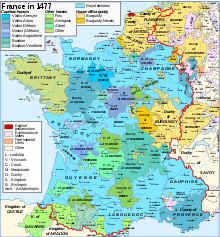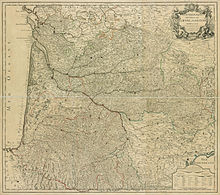Guyenne


Guyenne or Guienne (French: [ɡɥijɛn]; Template:Lang-oc [ˈɡjanɔ]) was an old French province which corresponded roughly to the Roman province of Aquitania Secunda and the archdiocese of Bordeaux.
The name "Guyenne" comes from Aguyenne, a popular transformation of Aquitania.[1] In the 12th century it formed, along with Gascony, the duchy of Aquitaine, which passed under the dominion of the kings of England by the marriage of Eleanor of Aquitaine to Henry II.
In the 13th century, through the conquests of Philip II, Louis VIII and Louis IX, it was confined within the narrower limits fixed by the treaty of Paris (1259). It was at this point that Guyenne became distinct from Aquitaine. Guyenne then comprised the Bordelais (the old countship of Bordeaux), the Bazadais, part of Périgord, Limousin, Quercy and Rouergue and the Agenais ceded by Philip III to Edward I in 1279. Still united with Gascony, it formed a duchy extending from the Charentes to the Pyrenees. This duchy was held as a fief on the terms of homage to the French kings and, both in 1296 and 1324, it was confiscated by the kings of France on the ground that there had been a failure in the feudal duties.
At the treaty of Brétigny (1360), King Edward III of England acquired the full sovereignty of the duchy of Guyenne, together with Aunis, Saintonge, Angoumois and Poitou. The victories of Bertrand du Guesclin and Gaston III, Count of Foix, restored the duchy soon after to its 13th-century limits. In 1451, it was conquered and finally united to the French crown by Charles VII. In 1469, Louis XI gave it in exchange for Champagne and Brie to his brother Charles, Duke of Berry (1446–1472), after whose death in 1472, it was again united to the royal dominion.
Guyenne then formed a government (gouvernement général) which from the 17th century onwards was united with Gascony. The government of Guyenne and Gascony (Guienne et Gascogne), with its capital at Bordeaux, lasted until the end of the Ancien Régime (1792). Under the French Revolution, the departments formed from Guyenne proper were those of Gironde, Lot-et-Garonne, Dordogne, Lot, Aveyron and the chief part of Tarn-et-Garonne.[2]
References
- ^ Xavier de Planhol, An Historical Geography of France (Cambridge, 1994), p. 168.
- ^ This article incorporates text from a publication now in the public domain: Chisholm, Hugh, ed. (1911). "Guienne". Encyclopædia Britannica. Vol. 12 (11th ed.). Cambridge University Press.
Further reading
- Pépin, Guilhem (2006). "Les cris de guerre " Guyenne ! " et " Saint Georges ! "". Le Moyen Âge. 112 (2): 263–81. doi:10.3917/rma.122.0263.
{{cite journal}}: Invalid|ref=harv(help)
- Guyenne
- Former provinces of France
- History of Aquitaine
- Geography of Aveyron
- Geography of Charente
- Geography of Corrèze
- Geography of Dordogne
- Geography of Gironde
- Geography of Lot (department)
- Geography of Lot-et-Garonne
- Geography of Tarn-et-Garonne
- History of Nouvelle-Aquitaine
- History of Occitanie
- History of Aveyron
- History of Charente
- History of Corrèze
- History of Dordogne
- History of Gironde
- History of Lot (department)
- History of Lot-et-Garonne
- History of Tarn-et-Garonne

